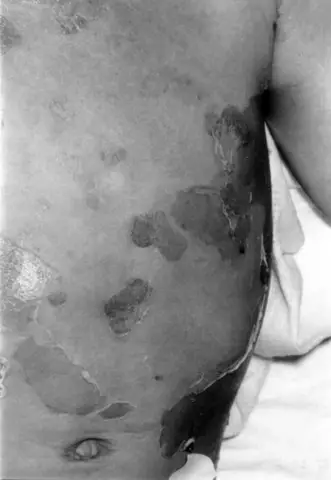- Author Curtis Blomfield [email protected].
- Public 2023-12-16 20:44.
- Last modified 2025-01-23 17:01.
Diseases of the skin cover belong to a separate group - dermatological pathologies. There are a lot of varieties. Accurate diagnosis of dermatological diseases is important for the selection of adequate treatment. One of the first methods is a physical examination. It begins with an examination of the skin and checking for characteristic symptoms. Based on these data, similar diseases can be distinguished from each other. One of the frequent manifestations of dermatological pathologies is Nikolsky's symptom. In most cases, it occurs in various types of pemphigus.

Nikolsky's symptom - what is it?
This manifestation of dermatological pathologies has been known since the end of the 19th century. Nikolsky's symptom is common in pemphigus, but can also occur in other diseases. It consists in the detachment of the skin under the influence of friction. This is due to the process of acantholysis. This medical term implies changes in the prickly layer of the epidermis, as a result of which disturbances in intercellular communications develop. Symptom Nikolsky must be checked both on the skin and onmucous membranes. Often it can be found in the oral cavity. This is due to the fact that some types of pemphigus begin to develop from the gums and the inner surface of the lips.

What diseases does this symptom occur in?
It should be noted that the symptom of Nikolsky in pemphigus is not always found. This disease has several forms. Most of the varieties of pemphigus are accompanied by acantholysis. At the same time, a positive variant of Nikolsky's symptom is noted. There are the following types of disease:
- Vulgar pemphigus. This pathology affects mainly women aged 40 to 60 years. In this case, violations of the oral mucosa are observed. Bubbles appear on the surface of the gums, tongue, cheeks. After opening them, erosion remains.
- Vegetative pemphigus. This type differs in that, in addition to the oral cavity, areas of the skin are affected. Most often these are inguinal folds, armpits, anus, umbilical ring. Bubbles are located more superficially and have a smaller shape. The disease is rare.
- Pemphigus foliaceus. It has a sudden onset and rapid development. Bubbles are localized on the hairy areas of the body, head. After opening them, thin crusts remain (reminiscent of sheets of skin).
All these types of pemphigus are acantholytic forms. Nikolsky's symptom with them is positive. It is negative for other types of the disease.

Diagnosis of Nikolsky's symptom
There are 3 ways in which Nikolsky's symptom can be diagnosed with pemphigus (photos of the disease are presented in the article). In the first case, the doctor pulls the lid of the bladder with tweezers. At the same time, he althy skin is shed in the form of a ribbon. The second way is to rub the epidermis between the bubbles. At the same time, the skin, which seemed he althy, also begins to be rejected. In the third case, the doctor makes sliding movements in areas far from the bubbles. In these places, the epidermis is easily damaged, leaving an erosive surface.






